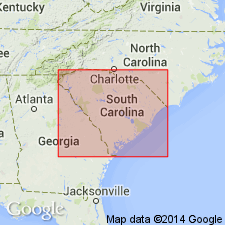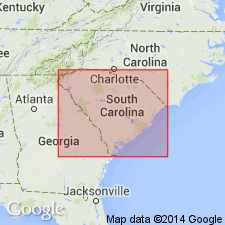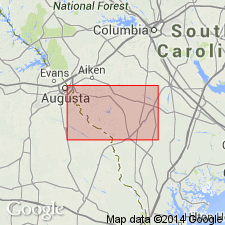
- Usage in publication:
-
- Barnwell sands
- Modifications:
-
- Named
- Dominant lithology:
-
- Sand
- AAPG geologic province:
-
- Atlantic Coast basin
Summary:
Named Barnwell sands for Barnwell Co., SC. First used on South Carolina Geological Survey geognostic map, 1904 (advance copies). The littoral line of Barnwell phase irregularly overlaps upper margin of Santee marls, which extend from Shell Bluff east by Tinkers Creek, Orangeburg, Keitt Ravine and south along east ridge of Santee River; along some ridges this littoral line extends almost to the fall line. The area along the Savannah River extends south to Johnson's Landing, where it passes under King's Creek Silex, which near Cohens Bluff passes under Brier Creek marl. From Johnson's Landing the line of southerly exposure of this formation passes near Fairfax, and probably curves toward Scotchmans Bluff. The Barnwell consists of silicified shells and decomposed glauconite sands, partly indurated to sandstone. Unit is of late Eocene age.
Source: GNU records (USGS DDS-6; Reston GNULEX).

- Usage in publication:
-
- Barnwell Group
- Modifications:
-
- Areal extent
- AAPG geologic province:
-
- Atlantic Coast basin
Summary:
The Dry Branch Formation and Tobacco Road Sand compose the Barnwell Group in the upper Coastal Plain of eastern GA and western SC. The Griffins Landing Member occurs at the base of the Dry Branch in both SC and GA. The Clinchfield Sand occurs at the base of the Barnwell Group in GA and has been recognized in SC by Harris and Zullo (1988). In SC, unit unconformably overlies the lower middle Eocene Huber and Congaree Formations or the upper middle Eocene McBean Formation. Unconformably underlies the middle Miocene(?) upland unit. Age is Jacksonian.
Source: GNU records (USGS DDS-6; Reston GNULEX).

- Usage in publication:
-
- Barnwell Group*
- Modifications:
-
- Mapped 1:100k
- Dominant lithology:
-
- Limestone
- Marl
- Clay
- Sand
- AAPG geologic province:
-
- Atlantic Coast basin
- South Georgia sedimentary province
Summary:
Pg. 5, 10-11, 14, 21, geol. map. Barnwell Group of Huddlestun and Hetrick (1979, 1986). Includes (ascending) Clinchfield Formation, Dry Branch Formation, and Tobacco Road Sand. Consists of sandy limestone, marl, clay, and sand deposited during one transgression and regression of the sea. Base is marked by a 0.6 m (2 feet) thick unconformable lag bed of very coarse, angular quartz sand, quartz gravel, perforated shell fragments, lignite fragments, clay balls. Unconformably overlies McBean Formation; unconformably underlies "Upland unit" (after Nystrom and Willoughby, 1982, South Carolina Geol. Survey, South Carolina Geol. Soc. Field Trip Gdbk; =Hawthorne Formation of Siple, 1967, USGS Water-Supply Paper 1841). Age is considered late Eocene (latest Bartonian to Priabonian; Jacksonian).
Source: Publication.
For more information, please contact Nancy Stamm, Geologic Names Committee Secretary.
Asterisk (*) indicates published by U.S. Geological Survey authors.
"No current usage" (†) implies that a name has been abandoned or has fallen into disuse. Former usage and, if known, replacement name given in parentheses ( ).
Slash (/) indicates name conflicts with nomenclatural guidelines (CSN, 1933; ACSN, 1961, 1970; NACSN, 1983, 2005, 2021). May be explained within brackets ([ ]).

